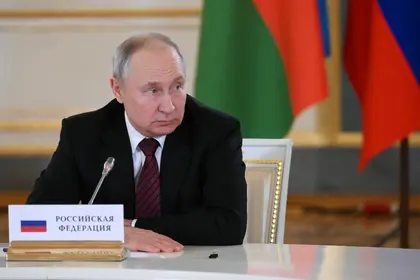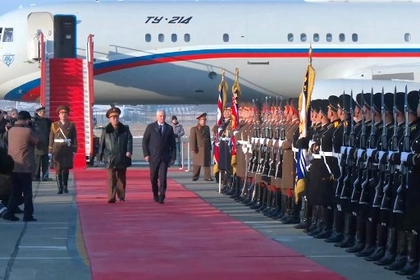Long before the 2022 invasion, when the subject of Ukrainian desire to join NATO came up at the 2008 Bucharest summit, Putin claimed, that “Ukraine is not even a state!” He went even further in his 2021 essay, “On the Historical Unity of Russians and Ukrainians.”
There is little doubt that he sees the existence of Ukraine and all things Ukrainian as simply a modern artificial construct and, therefore, not a real nation. Last weekend he took another opportunity to try to persuade the world, or at least his population, of the truth of his thesis.
JOIN US ON TELEGRAM
Follow our coverage of the war on the @Kyivpost_official.
The TV channel, Russia 24, broadcast a discussion between Putin and the Chairman of the Russian Constitutional Court, Valery Zorkin, during which they examined a 17th-century map which Putin maintained ‘proved’ Ukraine was not a real country.
The discussion centered on the map that Zorkin claimed had been compiled by the French during the time of Louis XIV. Zorkin said it showed that “there is no Ukraine there” – only the Polish-Lithuanian Commonwealth, “Cossackia,” and the Kingdom of Muscovy.
Putin responded: “It is common knowledge [that] these lands were simply part of the Polish-Lithuanian Commonwealth, and then they were asked to become part of the Kingdom of Muscovy… it was only later, after the October Revolution, that quasi-state formations began to form. The Soviet government created Soviet Ukraine. There was never any Ukraine in the history of humanity up to that point.”

‘We Need to End That Horrible, Horrible War’ – Ukraine at War Update for Dec. 23
Even a cursory glance at the map, which presumably the viewers of the Russia 24 program weren’t given, shows inscriptions identifying ‘Ukraine ou Pays des Cosaques’ (Ukraine or the country of the Cossacks) and Crimea falling into the area marked as belonging to the Tartars – not Russia.
The map was produced by Guillaume Sanson (1633-1703), a French cartographer who worked in the court of the king of France from 1667, taking on the role following the death of his father who also filled the post. He was responsible for producing several hundred different maps covering Europe, the Americas and North Africa. These are readily accessible through the French online library ‘Gallica.’
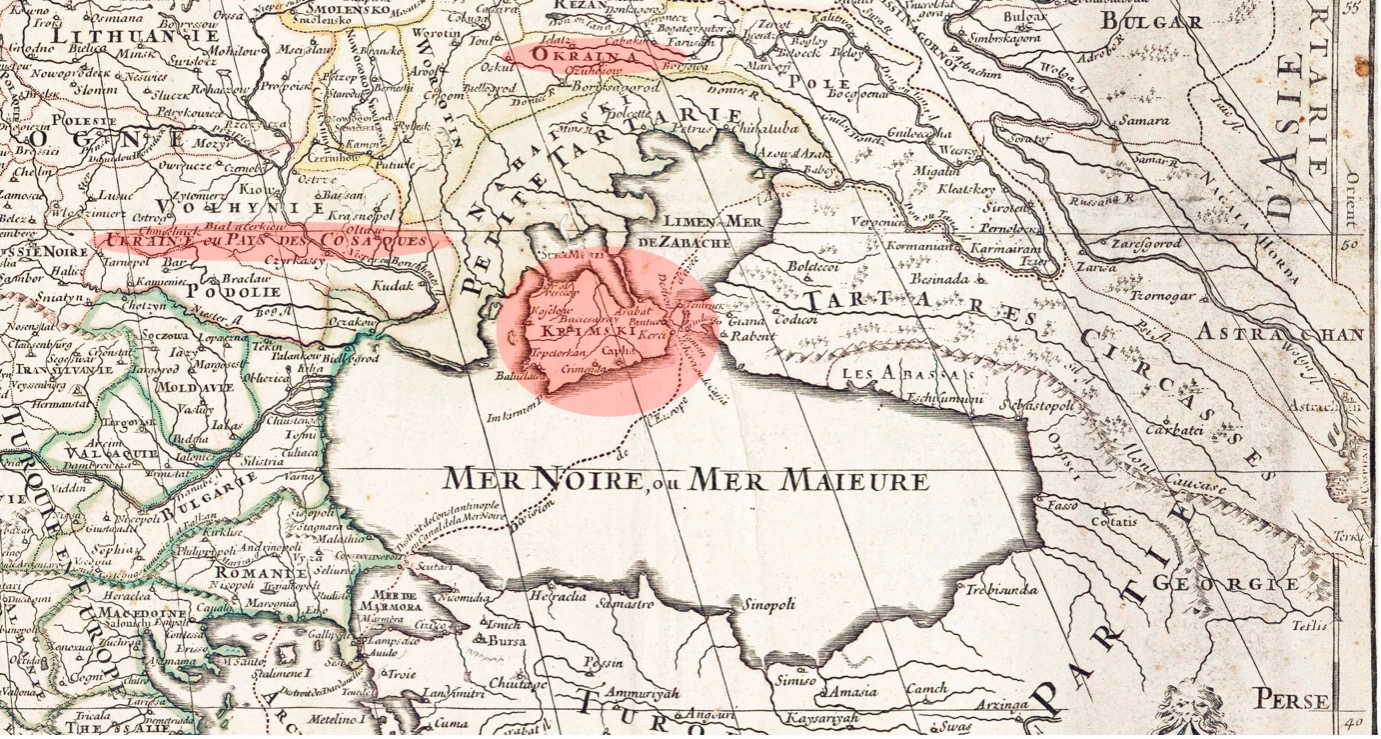
Detail of a 17th-century map depicting Ukraine
Map: Gallica on-line library
The true history of Ukraine
Long before the full-scale invasion, the belief that Ukraine is not a country, but a historical part of Russia, was deep-rooted in the minds of many Russians and one that Putin, in particular, feels unusually passionate – some would say maniacally – about. Many Russians base this belief on the fact that ‘Kyivan Rus,’ the ninth-century medieval state that was centered on present-day Kyiv, is seen as the foundation for both modern Russia and Ukraine.
In reality, Kyivan Rus consisted of fragmented principalities without a single identity before the southwestern territories, including Kyiv, were conquered and ruled by Poland and Lithuania in the early 14th century and remained so for almost 400 years. This resulted in a culture and identity that was distinct from the territories under Muscovite rule.
The Ukrainian language emerged in the dying days of Kyivan Rus, proving that Putin’s claim that “the first linguistic differences [between Ukrainians and Russians] appeared in the 16th century” was, like so many of his assertions, factually incorrect. During the Polish-Lithuanian rule, the Ukrainian language evolved separately from its Russian roots. These differences were, also in Putin’s mind, exacerbated by religious divisions that developed within Eastern Orthodoxy, from the 15th century.
While most of what is now Ukraine was governed by the Polish-Lithuanian nobility, its inhabitants formed themselves into groups of peasant warriors: the Cossacks. Cossacks had no desire to be ruled by either Poles or Muscovites and form their own statelets, such as the ‘Zaporozhian Sich’ and the Cossack ‘Hetmanate’, which constantly fought with one or other of the larger states and each other until, in 1667, Moscow took control of Kyiv and the territories to the east, and Warsaw the lands to the west.
The Cossacks frequently fought against their status as a Muscovite vassal state with sporadic uprisings against the Tsars. In 1708, for instance, the Cossack’ leader Ivan Mazepa, allied himself with Sweden’s Charles XII to fight against Muscovy. If Putin, the former lowly KGB officer were better educated and read, he would have known that in in his history of Charles XII published in 1731 Voltaire wrote the famous line: “L’Ukraine a toujours aspiré à être libre.” (Ukraine has always wanted to be free.)
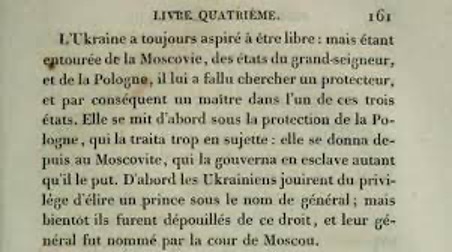
By the end of the 18th century, Russia – the name adopted for the Muscovite state by Peter I after defeating the Swedes and Mazepa at Poltava in 1709, destroyed the Zaporozhian Sich and the remaining Cossack institutions of self-governance, with the Russian Empire gradually absorbing the remainder of modern-day Ukraine, apart from its extreme west, which was annexed by Austria.
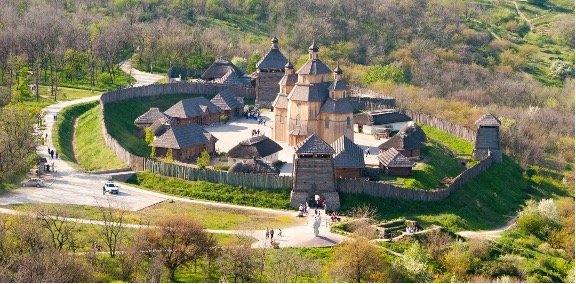
The ‘Zaporozhia Sich’ historical and cultural complex. Photo: Alexey Tolmachov/ wikicommon
Ukraine remained a part of the Russian state for the next 120 years. First Russia’s imperial authorities, then the Soviets, systematically tried to suppress Ukrainian culture and the Ukrainian language. In spite or perhaps because of this, a distinct Ukrainian national identity emerged and was strengthened, particularly as a result of the ‘Holodomor’, the Stalin-instigated famine that killed between three and five million Ukrainians in 1932-33.
Armed revolts against Soviet rule, centered on the western regions of Ukraine during and after World War II, tried to engineer independence but it was only with the collapse of the Soviet Union in 1991 that Ukraine gained independent statehood.
Ukraine, like many European countries, evolved over time as minor kingdoms or statelets were absorbed or made alliances or were simply swept away by the tide of history. The precise borders of historical Ukraine are difficult to establish but Putin’s statements that present-day eastern or southern Ukraine was part of “the historical South of Russia” is simply wrong – fake history.
Settlement of these vast territories only began in the 19th century, and it retained a diverse ethnic make-up, perhaps exemplified by the fact that it was British industrialists who founded Luhansk and Donetsk the two cities at the center of the current separatist conflict.
His other claim that Ukraine’s south-eastern borders were established “with no consideration for the ethnic make-up of the population” is equally false. The Soviet census of 1926, shortly after the borders of the Ukrainian SSR were finalized, showed that ethnic Ukrainians still far outnumbered ethnic Russians. It was Stalin’s Russification process of the 1930s, that substantially changed the demographic make-up of ‘the Donbas.’
The frontlines of this war between Ukraine and Russia are a result of Putin’s intentionally distorted reading of the past which, in the long run, will have done irreparable damage to Russia and its international standing. In addition, his attacks on Ukraine have driven Ukrainians away from their previous peaceful and respectful relationship with Russia and the links between the two countries, to total aversion towards Russia and everything Russian.
You can also highlight the text and press Ctrl + Enter


